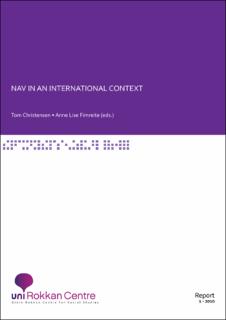| dc.contributor.author | Christensen, Tom | |
| dc.contributor.author | Fimreite, Anne Lise | |
| dc.coverage.spatial | Norge | nb_NO |
| dc.date.accessioned | 2019-11-13T12:16:56Z | |
| dc.date.available | 2019-11-13T12:16:56Z | |
| dc.date.issued | 2010 | |
| dc.identifier.isbn | 978-82-8095-067-3 | |
| dc.identifier.issn | 1503-4844 | |
| dc.identifier.uri | http://hdl.handle.net/11250/2628226 | |
| dc.description.abstract | The NAV-reform is one of the largest coordination-oriented reforms in recent Norwegian public administration history. Following years of debate and negotiation, the government decided to merge two sector organizations with long traditions – the employment and national insurance services - into a new entity called the Norwegian Labour and Welfare Service (NAV) and to establish a partnership between the local branch of Nav and the municipalities which provide local social services. Norway is however not the only advanced welfare-state in Europe which has taken onboard this sort of reform-strategy when the welfare administrations are to be changes. Denmark, Germany and UK have all tried out reform-models that in many ways resemble the Norwegian one in this particular field. This report presents three papers that address those reforms by focusing on the role of parliament in the reform-processes, on the significance of ministries' task portfolio in the same processes and on how the local branches of welfare administrations are organized. | nb_NO |
| dc.description.sponsorship | Norwegian Research Council | nb_NO |
| dc.language.iso | eng | nb_NO |
| dc.publisher | Uni Rokkansenteret | nb_NO |
| dc.title | NAV in an international context | nb_NO |
| dc.type | Research report | nb_NO |
| dc.source.pagenumber | 85 | nb_NO |
| dc.relation.project | Evaluering av Nav-reformen | nb_NO |
